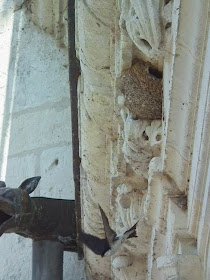Indeed they do, but sometimes these long distance migrators who return to the same place year after year are in for a nasty surprise, despite the fact that destroying their nests is a criminal offence.
A House Martin leaves its nest on the Chateau of Chenonceau.
This has happened on the gateway into the royal citadel at Loches, where the roof was repaired and I have not seen swifts nest there since. There is a high risk it will happen once the money for the repair of the roof of Saint Ours, on the citadel, is forthcoming. Private homeowners regularly destroy nests or access to nests either deliberately or unwittingly when they renovate. The problem is either that the mud nests of swallows or martins are knocked off, or gaps under the eaves are blocked up so that swifts can no longer access their nests in the roof spaces.
The school in Montrichard had a colony of swifts which nested in gaps in the walls, but over the autumn the building was restored and all these cavities were blocked up. This sort of change to a building is probably the single biggest reason that the population of hirondelles and swifts is in free fall. All these species are dependent on man for their nesting habitat. Unfortunately barns and stables, which make perfect habitat for all three species, are being gentrified and turned into modern homes or holiday accommodation. Even just insulating your roof can make the space unusable for swifts.
A number of Swifts (I can count four flying in this photo) raise their chicks in the roof space and holes in the walls of Saint Ours, Loches.
Many property owners find the mess swallows and martins make unacceptable and consequently destroy their nests. This is illegal and if deliberate intent can be established carries a penalty of up to six months in prison. Every year the National Office for Hunting and Wildlife intervenes with property owners to make them aware of the legislation.
Last year, however, a charge was made against a contractor who had knowingly destroyed twenty occupied House Martin nests. He will be going to court. The law prohibits any destruction of nests, even outside breeding season. House Martin and Barn Swallow nests are very obvious, but Swifts are very discreet, and a property owner could easily block cavities used by them for nesting without realising what they had done.
Young swallows sitting on wires outside our house.
Luckily the Montrichard school colony was spotted by League pour Protection des oiseaux (LPO) members. Thanks to their intervention with the local authority the planned work on the school's façade last summer was delayed, thus protecting chicks for that year at least. When work is needed on a building, solutions that take into account the birds do exist. The LPO, which has successfully installed a swallow tower in Herbault (Loir et Cher), contacted the authorities in Montrichard to discuss what they can do to mitigate the disruption to the Swifts.
*************************************************
Swift Care: It is possible that occasionally swifts will need to be hand reared. Carolyn has emailed me with the latest on how to care for swift chicks. She warns that some sections of the LPO site, which is otherwise full of great advice, recommends feeding grounded swifts with minced beef, beef burgers and cat and dog food. Vets have been known to recommend the same diet. Unfortunately, although swifts survive on this diet, it has been found that once they return to the wild they lose their feathers 8 - 10 days later. Something about the switch back to their natural diet of insects triggers this.
Cat and dog foods all contain ingredients that swifts really shouldn't be eating, such as vegetable material. The recommended diet for rescued swifts is dried insects (not treated with oil) or live mealworms that you can obtain from pet shops. The insects need to be dunked in water and the mealworms need their heads crushed. Earthworms are not suitable as the swifts pick up parasites from them.
There is also information about how to care for a grounded swift - in English - here.
There is also information about how to care for a grounded swift - in English - here.
This document describes in great detail how to care for a swiftlet. It is not something to be undertaken lightly.
****************************************************
Swift Awareness Walk: Edward Mayer from Swift Conservation is coming to Amboise to lead a swift walk, followed by a bat walk, on 2 and 3 July.




4 comments:
Great post... but the Wrens and Black Redstarts are unable to read and learn from this!!
They both love the swallows' nests here!
Where nests have been damaged, or decayed naturally in our dependances, I have noticed that the swallows always use a nail as a foundation.
One of the nests here is so old, that it has a coat of whitewash from when the sheds were veal sheds!
That is fourty years ago minimum!!
And it was in swallow use until three years ago... when a Black Redstart, arriving much earlier, decided that it was a suitable site...and last year, a wren used it for a third brood.
A terrible bit of newas to impart... the Fritillary field has been disc harrowed!!
Yes, the swallows use a nail or some other projection for the foundation of the nest. Our swallows and redstarts have separate nests and made them from scratch a few years ago.
The news about the Fritillary field is really disappointing. How close to the river has he ploughed?
Very... That field had over 100...probably 150 plants in flower a few weeks ago!!
So much for a national law protecting certain plants!!
Unfortunately the law doesn't protect any plant on agricultural land from the 'normal activities' of the farmer.
Post a Comment